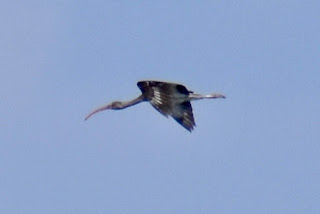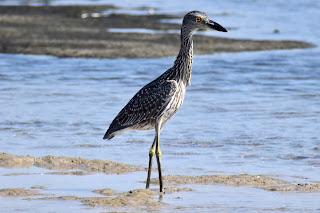Island Beach State Park Parasitic Jaeger, 9/7/23
On Thursday I had a chance to get out on my kayak and check out the sedges of the Marine Conservation Zone at the southern end of Island Beach State Park. At low tide I have the opportunity to walk around the exposed mud flats where many returning migrant shorebirds gather. I started a little later than I had originally planned. The tide was already incoming so while I was scanning flocks of shorebirds, gulls and terns, I had to also keep an eye on my beached kayak before the rising water could take it away.
This is a good time of year to find some rarities. In the past there have been sandwich terns, roseate spoonbill, reddish egret, Wilson’s phalarope, American golden plover and Hudsonian godwit among others. No rarities this time, however. In about an hour I saw scattered, around the mud flats, sandbars and marshes, increasingly large mixed flocks of gulls: great black-backed, herring, laughing, ring-billed and even a Bonaparte’s; terns: Caspian, royal, Forster’s and common; waders: yellow-crowned night-herons, white ibis, snowy egrets and great egrets; and shorebirds: American oystercatchers, willets, greater yellowlegs, marbled godwit, red knots, short-billed dowitchers, black-bellied plovers, semipalmated sandpipers and plovers, least sandpipers and sanderlings. The only decreasing population I noticed were the ospreys. Most of the nesting platforms scattered about the area were already vacated.
Left, juvenile white ibis. Right, juvenile yellow-crowned night-heron. © S. Weiss
Marbled godwit with two American oystercatchers. © S. Weiss
My surprise sighting of the day was afterwards when I finished off on the ocean beach, from the inlet driving north in my SUV. Along the way, I was seeing mostly the usual late summer subjects, many of the same gulls, terns and sandpipers that were on the bayside. Until a gull-sized, dark bird zipped past the front of my vehicle. Half of my brain thought "What the heck was that?" The other half knew exactly what it was. I quickly got my bins on it as it paralleled my vehicle and confirmed it was a jaeger! It was a parasitic jaeger and it was chasing a tern, or maybe a smaller gull. Whichever I didn’t care. I quickly backed my vehicle up and turned around to get some photographs. I fired off many shots (I leave my camera on sport mode setting for this reason), trying to focus as the sea pirate chased its victim both over the water and along the beach. It wasn’t hunting the tern/gull, but it was trying to force it to drop its fresh seafood catch. That’s what parasitic jaegers do. They are quick, and very agile in flight; able to turn on a dime.
Parasitic jaeger. © S. Weiss
The diamond shaped tail, with the longer central feathers, and the white flashes on the inner portion of the primaries are easy field marks for the jaeger. The hunting technique of the parasitic jaeger helps to recognize it too.
Parasitic jaegers are pelagic birds, but are the most likely of the three jaeger species to be seen from land in New Jersey. At times they can be seen giving chase to smaller terns or gulls feeding off the beach. However, this was the first one I have seen actually over land. It may have been waiting in ambush either on the beach or on the water, or flying high overhead looking for something with a mouth full of food. Whichever hunting technique it used, it put on a spectacular display. I don’t think the other beach goers noticed a thing, but I loved all ten seconds of it.










Comments
Post a Comment